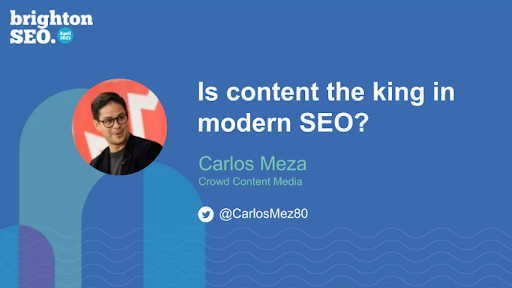A few talks at this year’s BrightonSEO April conference touched on themes of content and localisation within search engine optimisation (SEO). Croud’s Language Project Executive, Xiuting Huang, shares her thoughts and inspirations from the conference.
Content quality is one of the biggest challenges in today’s SEO. Many players in the game put too much emphasis on keywords and rankings but neglect the quality of content. People are chasing Google’s algorithms to get a top position in the search engine results pages (SERPs), not realising that the reason Google keeps updating the rules of the game is to improve the user experience.
That means, you will never be ahead of the game if you don’t care about your users’ reading experience. As Carlos Meza stressed in his talk, great content is the king of modern SEO. And if you want to go global, you need to have great localisations to ensure the king is not assassinated.
Funnily enough, although more and more SEOers are becoming aware of the value of quality content (in source language, mostly English), they still believe that direct/literal translations are good enough for foreign markets. For some reason, people fail to realise that localisation is a type of content that needs to be crafted.
Is content the king in modern SEO? – Carlos Meza, Crowd Content Media

Carlos Meza shared his suggestions on what makes content great. These following points should be taken equally as seriously when localisation is being carried out, as they are when they’re in the source language.
- Human-centric: use storytelling skills to produce easy to consume content, put the customer at the centre, evoke emotions for empathy.
- Brand tone of voice: what makes your brand stand out in a world where artificial intelligence (AI) is becoming the ‘norm’ brand tone of voice.
- Multiaccess: content has multiple types, and all of these should be created with different considerations. Content types can include short-term posts, long-term blogs, images, videos, etc.
- Experience: why should people believe you?
- Ability: do you know your stuff, and can you back it up?
- Leverage AI, Machine Learning (ML) and technology for productivity: How can you use AI and ML to help create better content? Croud’s Content Account Director, James Ball, also shared a few applications of ChatGPT-4 in his talk ‘ChatGPT-4: Localisation friend or foe’…
ChatGPT-4: Localisation friend or foe? – James Ball, Croud

Localisation is the foundation of international SEO. Low quality localisation can affect your business the same way that unsatisfactory content in your given source language can. Even worse, localisation failure could result in business loss. For example, KFC’s catchphrase ‘finger-licking good’ was poorly translated to ‘eat your fingers off’ in Chinese, which damaged the company’s reputation, turning the brand into an industry joke.
Localisation is an area that needs to be re-evaluated. Nowadays, many people still think that knowing two languages is sufficient enough for carrying out localisation tasks, which is completely wrong. This could be compared to the assumption that someone who can speak would automatically be good at public speaking, or that someone who can write, would also automatically become a great copywriter.
Even if you have a piece of excellent, optimised source content, it doesn’t mean you can expect machine translation, AI or a non-specialist to provide a satisfactory level of localisation. There is much more work to be done behind the scenes…
- User search trends are not the same in all markets, which means keyword research needs to be conducted again for target markets.
- Cultural values affect how people communicate. The way people express ideas in one language can be inappropriate or rude in another. In this case, transcreation is required to ensure that the target readers get the same feel from the text as source readers do. There are many more factors to consider than you might think.
Congratulations, you’re going global! What you wish someone told you – Hinde Lamrani – Acolad Group

To develop a successful international SEO strategy, it’s crucial to use the expertise of professionals who can go beyond mere literal translations, avoiding stereotypes in the process. Hinde Lamrani presented a basic localisation guide in her talk.
Hinde advised listeners to consider a few technical stacks before getting started: Content Management Systems (CMS), Translation Management Systems (TMS), plug-ins and post-editing apps.
Once your workplace is set, there are several questions you need to ask:
- Who will help you localise? – a language service provider? Freelancers? In-house? AI?
- Which of your assets need to be localised? Product pages? Blog posts? Videos?
- Which market should you localise for?
- Which digital assets should you use?
- Which localisation process should you go for?
And a few other points to consider:
- Time and budget
- Goals and key performance indicators
- Priorities
- Glossary, tone of voice, style guide
Hinde also highlighted that brands shouldn’t be siloed! – international SEO is an area where marketers, translators and product managers need to be on the same page.
It’s great to see localisation has a place in BrightonSEO and I believe this underrated area is worth more attention and discussion.
If you’re looking to learn more about localisation or curious about how localisation can work well with SEO, please get in touch with our Language Services Team at [email protected].



